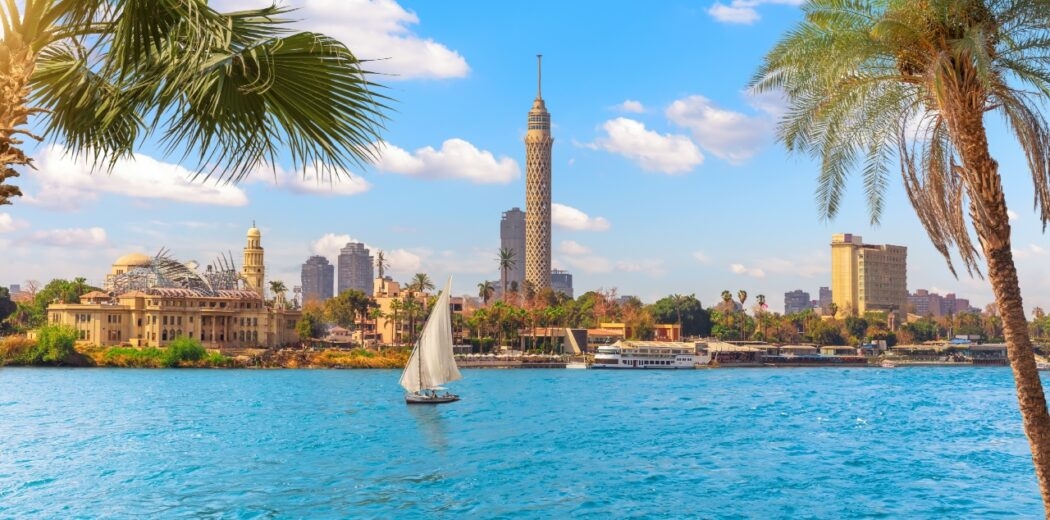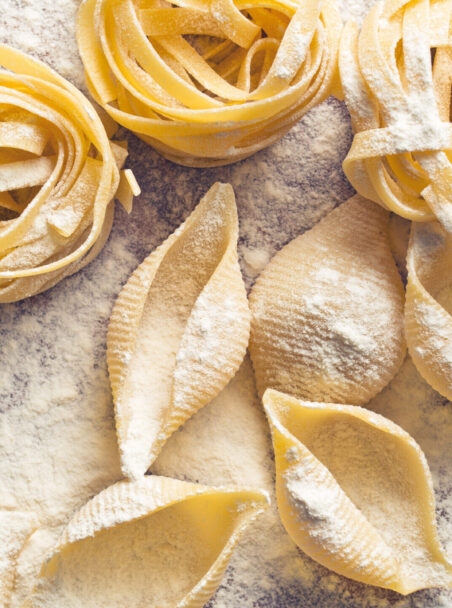The Middle East is not only a cradle of civilisation, but also the birthplace of an immensely influential style of cuisine. Middle Eastern food is a tasty tapestry of fresh ingredients, traditional cooking techniques and bold spices. Its specialties are as diverse and distinctive as the cultures of the 18 countries it comprises.
Middle Eastern cuisine includes world-famous dishes like falafel, hummus, shish kebabs, shawarma and baklava, as well as basic staples like bread, olives, rice and cheese. It often includes olive oil, sesame seeds, fresh herbs and seasonings like saffron, sumac, cumin, coriander, turmeric and nutmeg, creating complex flavour profiles.
The spectrum of Middle Eastern flavours and recipes is enormous, but we’ve done our best to capture its essence. Here’s our ultimate guide to Middle Eastern cuisine, covering its most essential ingredients, dishes, street foods, snacks, desserts and drinks – plus a peek into some regional variations.

Staple ingredients in Middle Eastern cooking
Many staples of Middle Eastern cooking are simple: chickpeas, sesame seeds, olive oil, lemon, wheat, rice, dates and nuts, just to name a few. These unassuming ingredients combine to create some of the world’s most delicious dishes (but more on that below). For now, let’s take a closer look at the basic elements of Middle Eastern cuisine.
First up: spices. Middle Eastern food isn’t usually super spicy (as in hot), but it is heavily seasoned. Staple spice mixtures include baharat, made from a variable blend of cumin, pepper, paprika, cloves, cinnamon and more, and za’atar, which usually includes thyme, sumac and sesame seeds. You’ll also find coriander, cardamom, caraway, anise and many other spices.
Middle Eastern recipes often rely heavily on olive oil and fresh produce. Aubergines, tomatoes, peppers, squash and beets add colour to lots of traditional dishes, and dried fruits are common in both sweet and savoury recipes. Many healthy Middle Eastern foods also include plant-based proteins like chickpeas, lentils and fava beans.
The most common meat in the Middle East is probably lamb, though you’ll also find mutton and chicken (pork is less common for religious reasons). Many main dishes are served with rice, bulgur, freekeh (made from durum wheat) or flatbreads like pita, saj or lavash. As for dessert, common ingredients include dates, honey, nuts, seeds, rose water and orange blossom water.
Traditional cooking class in Petra
“Petra is renowned for its vibrant spice trade, so there’s no better location for your introduction to Arabic cooking. This privately guided cooking class immerses you in the intoxicating world of spices, while giving you a hands–on experience in a traditional Arabic kitchen. Your chef host will talk you through the preparation, explaining the cultural significance of each dish, before you all sit to enjoy the mouthwatering feast you’ve prepared.”
Delve deeper
Speak to Rosie, our Middle East expert, about your own foodie adventures around Petra, and hear her recommendations for other incredibly delicious experiences.

Traditional Middle Eastern dishes
Traditional Middle Eastern cuisine is an incredibly broad category, containing enough mouthwatering dishes to fill shelves upon shelves of cookbooks. Each Middle Eastern country has its own culinary traditions and classic recipes, but there are some specialties that form a common thread throughout the region – albeit with local variations and twists.
One such dish is falafel, which can be made with chickpeas or fava beans (or both) depending on the country. It’s often served with tahini, a creamy sauce made from sesame seeds, and hummus, which includes chickpeas, tahini, lemon and spices. All three may be served as part of meze (or mezze), an array of different dishes in small portions (sort of like Spanish tapas).
Other common meze options are cheese, olives, baba ghanoush (roasted aubergine dip), kibbeh (ground meat and bulgur, usually formed into small fritters), dolma (stuffed grape leaves) and salads like tabbouleh (with bulgur, tomatoes, mint and parsley) or fattoush (with crunchy vegetables and pieces of fried pita bread).

Meat plays a leading role in many of the most common Middle Eastern main dishes. There’s shawarma (thinly sliced, spit-roasted meat of various types), shish kebabs (grilled meat skewers), mansaf (lamb with fermented yoghurt), makloubeh (upside-down rice with vegetables and meat) and kofta (minced meat shaped into small spheres or cylinders).
There are also plenty of traditional Middle Eastern dishes that are vegetarian by nature. Try manakish (thin flatbreads topped with cheese or za’atar), Lebanese moussaka (stewed aubergine, chickpeas, tomatoes and onions) and mujadara (rice, lentils and fried onions). And when in doubt, the average meze spread usually has plenty of plant-based options.
Nothing brings people together like sharing a meal, and having dinner with a family in Jebel Akhdar promises an immersion in Omani hospitality and culture. You’ll be warmly welcomed by your host family and treated to a traditional Omani dinner with the breathtaking Al Hajar mountains as a backdrop. Savour dishes like salona or majboos as you get to know each other over the course of an unforgettable evening.

Jack Beckford
Travel Designer

Middle Eastern street food, snacks and sweets
We’ve already mentioned one of the most ubiquitous Middle Eastern street foods: falafel. Vendors are likely to sell it stuffed into a pita with veggies and sauces. Another common pita filling is shawarma, and you’ll also find kibbeh, kofta and shish kebabs on the streets of many Middle Eastern cities.
If you’re searching for a snack, look for manakish, arayes (baked or grilled pitas stuffed with ground meat) or fatayer (small pies filled with meat, spinach or cheese). And don’t overlook the wondrous world of Middle Eastern sweets, from the beloved baklava (filo pastry soaked in syrup or honey with nuts) to the super rich knafeh (crispy spun pastry with sugary syrup and cheese).
Taking a food tour is a fantastic way to sample as many Middle Eastern delicacies as possible. We offer a street food tour of Amman that includes hummus, falafel, grilled meats, cheese and locally made wine. Remember that if you’re visiting the Middle East during Ramadan, street food may be harder to come by.

Traditional Middle Eastern drinks
When it comes to Middle Eastern drinks, the first thing that springs to mind is coffee – Turkish coffee, to be exact. Although Turkey itself is only sometimes considered part of the Middle East, its eponymous style of coffee is popular throughout the region. It’s made by boiling coffee directly in water without straining out the grounds, creating a super strong and thick drink.
There are also plenty of cold beverages to keep you cool on hot days (if you’re worried about the heat, check out our guide on when to visit the Middle East). Limonana is an icy mint lemonade; laban ayran is a salted yoghurt drink; and qamar al-din is a sweet apricot nectar popular during Ramadan. You’ll also find juices made from tamarind, pomegranate and other fruits.
Regional variations in Middle Eastern cuisine
The Middle East is an enormous region, including parts of multiple continents and several million square kilometres, so it’s natural that there’s extensive cultural – and culinary – variation within it. Here’s a brief intro to some of the main regional variations in Middle Eastern cuisine.
Levantine cuisine
The Levant region includes Jordan, Lebanon, Syria, Palestine, Israel and part of Turkey (though the latter is sometimes classified as part of Europe). Typical Levantine cuisine features meze like falafel, fattoush, baba ghanoush, hummus, labneh (strained yoghurt) and muhammara (pepper and walnut dip), as well as kebabs, freekeh and various rice dishes.

Culinary culture of the Arabian Peninsula
The Arabian Peninsula encompasses the United Arab Emirates, Qatar, Oman, Saudi Arabia, Bahrain, Kuwait and Yemen. This is where Islam originated, and most locals are Muslim – so you won’t find much pork on the menu, and alcohol isn’t widely consumed. There are, however, plenty of delicious traditional foods to try, including the iconic kabsa (rice with meat and spices).

North African influences
Although geographically located in Africa, Egypt is generally considered part of the Middle East. Egyptian food has a lot in common with the rest of the region’s cuisine, but there are some differences. For example, Egyptian falafel is made with fava beans instead of chickpeas, and there are plenty of national specialties like koshary (a mix of rice, pasta, lentils and chickpeas).


A true taste of the Middle East in Amman
Embark on a culinary adventure through the captivating streets of Jordan’s capital, Amman, to experience the true essence of Middle Eastern cuisine. This street food tour offers an opportunity to venture off the beaten path, as your private guide takes you to savour their favourite street food hotspots, from family–run cafes to hidden gems tucked away down narrow streets.
Start early and go hungry – you’re in for a day filled with delicious bites of all kinds. You’ll begin with some Levantine favourites, sampling creamy hummus, crispy falafel and locally crafted cheeses before moving on to one of the Middle East’s most recognisable foods: the kebab. Relish the taste and smell of flavourful, perfectly spiced meats as your guide explains the significance and origin of each of the foods you have tried.
Finish your tour with one of the more surprising aspects of Jordan’s culinary tapestry – winemaking. Although a predominantly Muslim country, it has a longstanding history of making wine. Taste some local varieties as you learn about the fascinating tradition behind their creation.
Whatever you want from your adventure to the Middle East, our travel designers are ready to help:





















